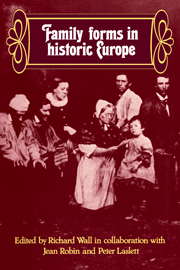Book contents
- Frontmatter
- Contents
- List of contributors
- Preface
- 1 Introduction
- 2 Two kinds of pre-industrial household formation system
- 3 ‘A large family: the peasant's greatest wealth’: serf households in Mishino, Russia, 1814–1858
- 4 The peasant family as an economic unit in the Polish feudal economy of the eighteenth century
- 5 The familial contexts of early childhood in Baltic serf society
- 6 Estonian households in the seventeenth and eighteenth centuries
- 7 Family and familia in early-medieval Bavaria
- 8 The property and kin relationships of retired farmers in northern and central Europe
- 9 Pre-industrial household structure in Hungary
- 10 The reconstruction of the family life course: theoretical problems and empirical results
- 11 The changing household: Austrian household structure from the seventeenth to the early twentieth century
- 12 Does owning real property influence the form of the household? An example from rural West Flanders
- 13 The evolving household: the case of Lampernisse, West Flanders
- 14 The composition of households in a population of 6 men to 10 women: south-east Bruges in 1814
- 15 The importance of women in an urban environment: the example of the Rheims household at the beginning of the Industrial Revolution
- 16 The household: demographic and economic change in England, 1650–1970
- 17 Family and household as work group and kin group: areas of traditional Europe compared
- References
- Index
10 - The reconstruction of the family life course: theoretical problems and empirical results
Published online by Cambridge University Press: 05 November 2011
- Frontmatter
- Contents
- List of contributors
- Preface
- 1 Introduction
- 2 Two kinds of pre-industrial household formation system
- 3 ‘A large family: the peasant's greatest wealth’: serf households in Mishino, Russia, 1814–1858
- 4 The peasant family as an economic unit in the Polish feudal economy of the eighteenth century
- 5 The familial contexts of early childhood in Baltic serf society
- 6 Estonian households in the seventeenth and eighteenth centuries
- 7 Family and familia in early-medieval Bavaria
- 8 The property and kin relationships of retired farmers in northern and central Europe
- 9 Pre-industrial household structure in Hungary
- 10 The reconstruction of the family life course: theoretical problems and empirical results
- 11 The changing household: Austrian household structure from the seventeenth to the early twentieth century
- 12 Does owning real property influence the form of the household? An example from rural West Flanders
- 13 The evolving household: the case of Lampernisse, West Flanders
- 14 The composition of households in a population of 6 men to 10 women: south-east Bruges in 1814
- 15 The importance of women in an urban environment: the example of the Rheims household at the beginning of the Industrial Revolution
- 16 The household: demographic and economic change in England, 1650–1970
- 17 Family and household as work group and kin group: areas of traditional Europe compared
- References
- Index
Summary
The family life course in history: sources and methodological problems
The importance of the developmental approach to the history of family life and to the changing structure of the individual family during its life cycle would now appear to be undisputed. It has not been easy, however, to adapt empirical study to meet the requirements of this approach, mainly because of the different sources available to researchers in different countries.
Our aim in this paper is to outline the possibilities and problems involved in the developmental approach when using serial household lists, a source common in Austria and elsewhere. The family life course, as we see it, embraces the entire household. Changes in household form we define as the family life course. The household lists are a type of annual census taken over long periods of time and not, as is more usual, perhaps once a century. This particular source therefore enables us to investigate households and their development over several generations.
There are detailed lists for a long series of years for the districts now known as Lower and Upper Austria. We have used lists for Andrichsfurt in Upper Austria, Gmünd in the Lower Austrian Waldviertel, Rappoltenkirchen in the Vienna Woods, and Maria Langegg in the Dunkelsteiner Wald, limiting the study to rural areas in the nineteenth century.
The possibilities of analysing serial household lists are many. Like single listings, serials throw light on the population according to age, marital status, and household position, whether spouse, child, servant, etc.
- Type
- Chapter
- Information
- Family Forms in Historic Europe , pp. 309 - 346Publisher: Cambridge University PressPrint publication year: 1983
- 18
- Cited by



